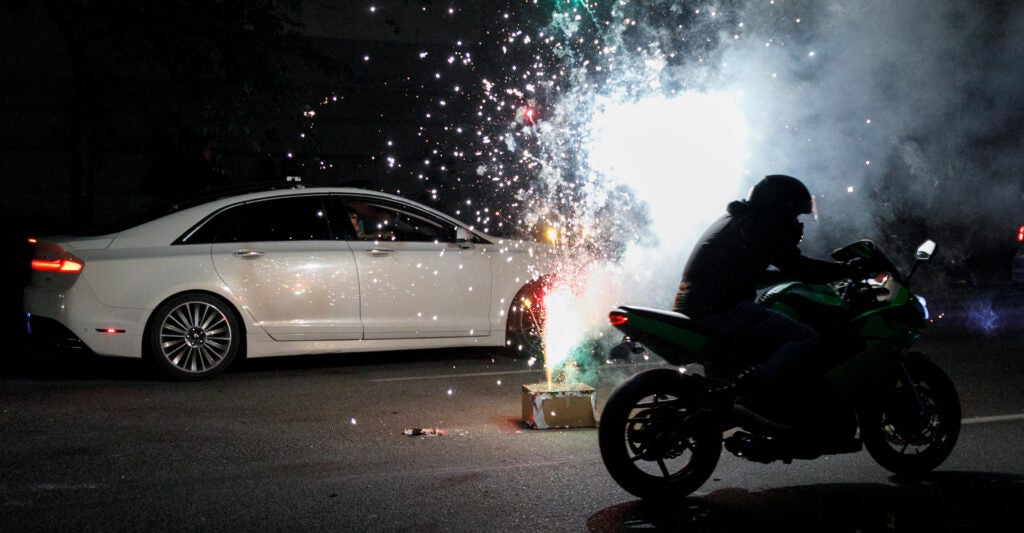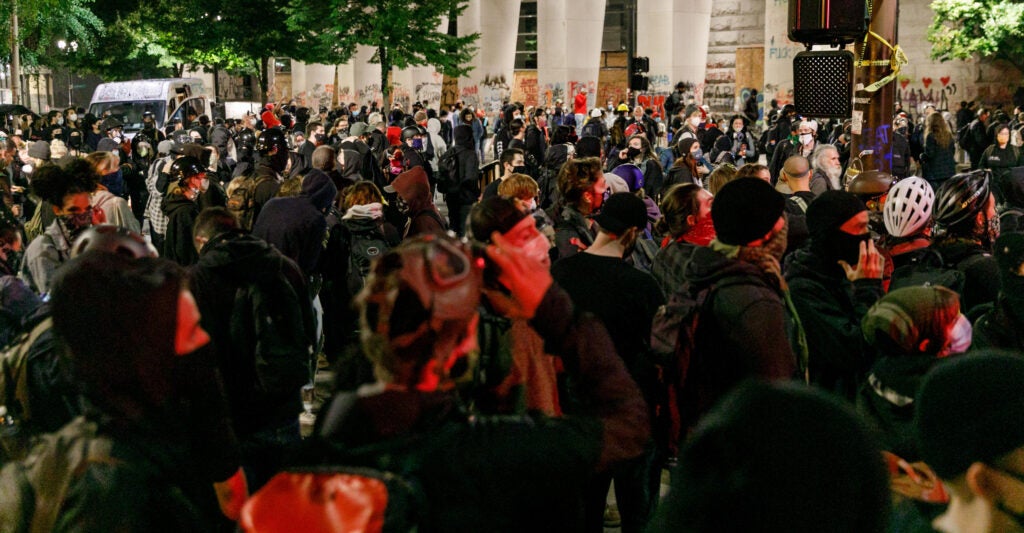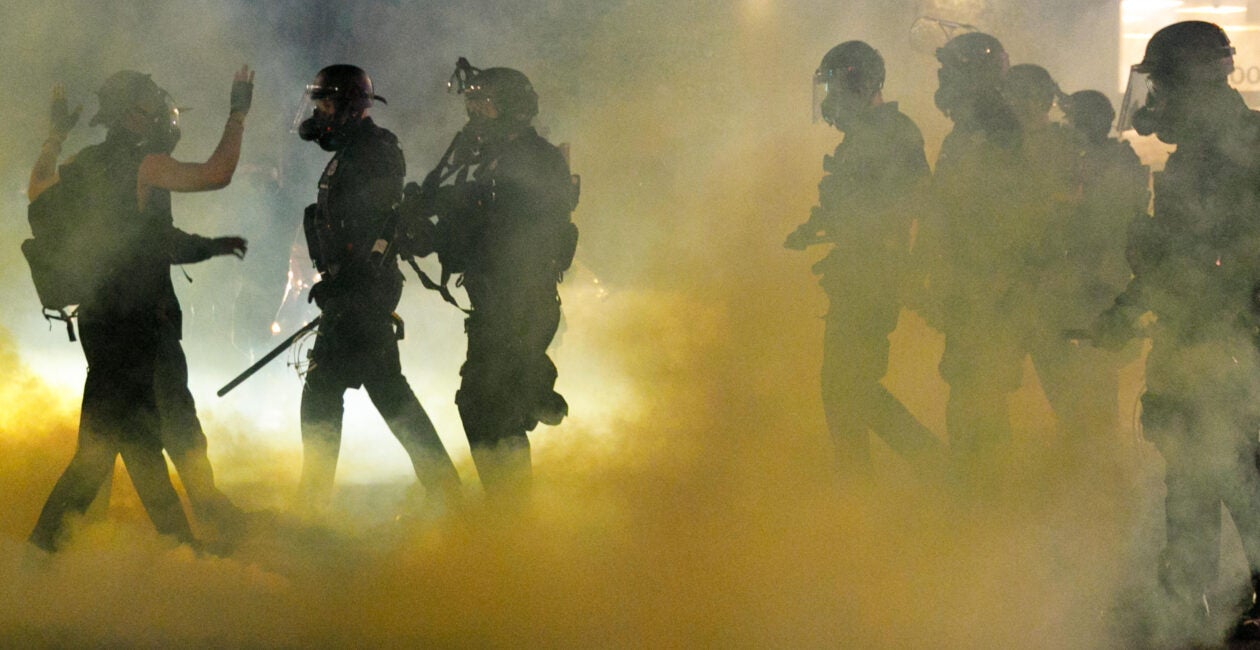Residents of the Portland area have “become accustomed to chaos,” says William Deatherage, 22, a recent college graduate who has lived in a suburb of the Oregon city since he was 5 years old.
“It’s safe during the day, but with all the litter and graffiti and statues torn down, I don’t even like to go there anymore,” Deatherage told The Daily Signal. “It’s not the city I grew up knowing.”
After 50 days of unrest that included repeated vandalism and use of fireworks downtown, including at two federal buildings, the U.S. Department of Homeland Security’s actions to curb rioters in Portland prompted a new controversy.
The Daily Signal depends on the support of readers like you. Donate now
About 200 demonstrators marched Thursday night outside the Portland Police Department’s East Burnside precinct station, and the department announced that they had threatened to burn down the station.
Oregon politicians sharply criticized the Trump administration’s efforts to quell the violence and protect federal property.
But acting Homeland Security Secretary Chad Wolf, who visited Portland on Thursday, called the rioters “violent anarchists.”
Wolf defended his department’s actions on Twitter.
Here are some important things to know about what’s happening in Portland.
1. Timeline of Chaos
The violence began May 29, four days after the death of George Floyd in police custody in Minneapolis when an officer pressed a knee into the prone, handcuffed man’s neck for almost nine minutes.
That first day, rioters broke a front window and painted graffiti on the Mark O. Hatfield U.S. Courthouse on Third Avenue in Portland, causing $5,000 worth of damage, according to the Department of Homeland Security.
The next day, demonstrators—many apparently identifying with the Black Lives Matter movement—defaced several other buildings with graffiti, including the Hatfield Courthouse and the Edith Green-Wendell Wyatt Federal Building, also on Third Avenue.
Over the next several days, vandals spray-painted the two federal buildings along with numerous other local government buildings.
On June 6, rioters destroyed fencing around federal property. The next night, they breached the fence at Hatfield Courthouse. The following night, they broke more windows at the courthouse and cut a hole in the fence surrounding the building. Two days later, they removed the entire fence.
On June 11, rioters dismantled the fence around the Green-Wyatt Building. Several more nights of vandalism, mostly involving graffiti, followed.
Then, on June 20, some in a crowd of 400 used commercial-grade lasers to try to cause eye damage to police officers, authorities said.
By June 30, rioters had ripped off plywood covering windows of the Green-Wyatt Building, then proceeded to break windows in the two federal buildings.
On July 2, rioters refused to vacate the area of the Hatfield Courthouse. They launched fireworks and threw objects at police officers, and some used lasers that could cause eye damage. Someone launched an explosive firework into the courthouse.
The next night, rioters broke another window in the courthouse and fired more fireworks into the building.
On Independence Day, rioters again shot fireworks into the courthouse, including mortar-style fireworks, according to the Department of Homeland Security. They also destroyed a security camera.
Several participants carried rifles, and one driver attempted to strike a Portland police officer with his car in front of the courthouse, authorities said.
Matters continued to get worse July 5, when rioters injured two police officers, causing one possible concussion.
Police arrested two persons, one of whom carried what appeared to be a pipe bomb. Rioters also set fires at the federal courthouse and in Chapman Park.
The next night, police arrested five on charges of assaulting officers.
In what rioters called a “Night of Rage” on July 7, many in a mob of about 500 assaulted law enforcement officers, according to DHS. About 200 participants pursued officers and assaulted them with rocks and bottles, officials said.
On July 8, about 200 rioters attacked DHS law enforcement officers, the agency said, injuring three. Authorities reported one arrest.

2. DHS Responds
In the past week, the Department of Homeland Security began stepping up a direct response.
“A federal courthouse is a symbol of justice—to attack it is to attack America,” Wolf said in a public statement Thursday. “Instead of addressing violent criminals in their communities, local and state leaders are instead focusing on placing blame on law enforcement and requesting fewer officers in their community.”
The acting homeland security secretary added:
This failed response has only emboldened the violent mob as it escalates violence day after day. This siege can end if state and local officials decide to take appropriate action instead of refusing to enforce the law. DHS will not abdicate its solemn duty to protect federal facilities and those within them.
Authorities arrested three people July 10 on charges of assaulting a federal officer. A DHS team stopped an attempted ambush of Portland police officers, the agency said.
Another four arrests followed July 11, including one person who allegedly tried to assault a police officer with a hammer.
“The problem is the rioters were given an inch and they took a mile,” Deatherage, who works in The Heritage Foundation’s information technology division, told The Daily Signal. “If the local governments are not going to stop this or can’t, someone needs to step in.”
“So many livelihoods are destroyed and lives are put at risk,” he said. “Having outside actors is aggravating, but it’s either aggravation with some protection or no protection.”
On July 12, a mob of about 200 gathered in Chapman Park across from the Hatfield Courthouse, some armed with sledgehammers, tasers, and stun guns. DHS said participants “launched fireworks, threw fecal matter and large objects, and pointed lasers at federal law enforcement officers.”
This activity continued the next night, with slingshots and flaming debris added to the mix, authorities said. Fireworks and spray-painting followed on subsequent nights.
The Oregonian newspaper reported that about 200 demonstrators lined up Thursday outside the police station in the East Burnside precinct and chanted: “Who do you protect? Who do you serve?” At 10 p.m., officers heard some threaten to burn the building down, police said.
Someone lit a small fire in the street near the police station, Fox News reported.
DHS officials wearing camouflage appeared to be trying to quell the violence Thursday night. Footage of arrests stirred controversy, The Oregonian reported, but DHS officers “retreated and their efforts to quell the protests seemed to have ceased.”
Last summer, adherents of the violent, radical group Antifa brutally attacked journalist Andy Ngo in Portland. Here’s what he had to say about the group:
3. DHS Overreach?
One protester live-streamed the unrest and complained about the federal response.
The protester, Kat Krimson, told KATU-TV in Portland: “The feds have just been so aggressive; they don’t talk. My boyfriend has walked the line and been like, ‘Hey, why are you guys here? What are you doing?’ And they’ll ignore him.”
The Washington Post, in a Friday news story, characterized the federal response in ominous terms. The newspaper wrote that “several men in green military fatigues and generic ‘police’ patches sprang out of an unmarked gray minivan in front of Mark Pettibone in the early hours of Wednesday morning.”
Pettibone, 29, told the Post: “I was terrified. It seemed like it was out of a horror/sci-fi, like a Philip K. Dick novel. It was like being preyed upon.”
Federal authorities detained Pettibone at the federal building, read him his Miranda rights, and then asked if he would answer questions. When he declined, they released him without charges, according to the Post.
The American Civil Liberties Union complained that the federal agents’ actions were “flat-out unconstitutional” and accused federal agents of “kidnapping” protesters.
The Post reported that federal agents fired a nonlethal substance to disperse the crowd, hitting one protester in the head and fracturing his skull.

4. Oregon Politicians Push Back
Oregon’s Democratic politicians mostly used the situation in Portland to stir the partisan divide.
Sen. Ron Wyden, D-Ore., complained about the protester who was hit in the head by the nonlethal deterrent, saying: “A peaceful protester in Portland was shot in the head by one of Donald Trump’s secret police,” without specifying the use of a nonlethal projectile.
Wyden also complained about Trump’s “occupying army.”
Portland Mayor Ted Wheeler, a Democrat, refused to meet Thursday with Wolf, the acting homeland security secretary.
“A number of people have asked if I know DHS leadership is in town, and if I’m going to meet with them,” Wheeler tweeted. “We’re aware that they’re here. We wish they weren’t. We haven’t been invited to meet with them, and if we were, we would decline.”
The mayor blamed a “coordinated strategy from the White House” to escalate tensions in the city.
Oregon Gov. Kate Brown, a Democrat, accused Trump of “political theater.”
“This political theater from President Trump has nothing to do with public safety,” Brown tweeted. “The President is failing to lead this nation. Now he is deploying federal officers to patrol the streets of Portland in a blatant abuse of power by the federal government.”






























